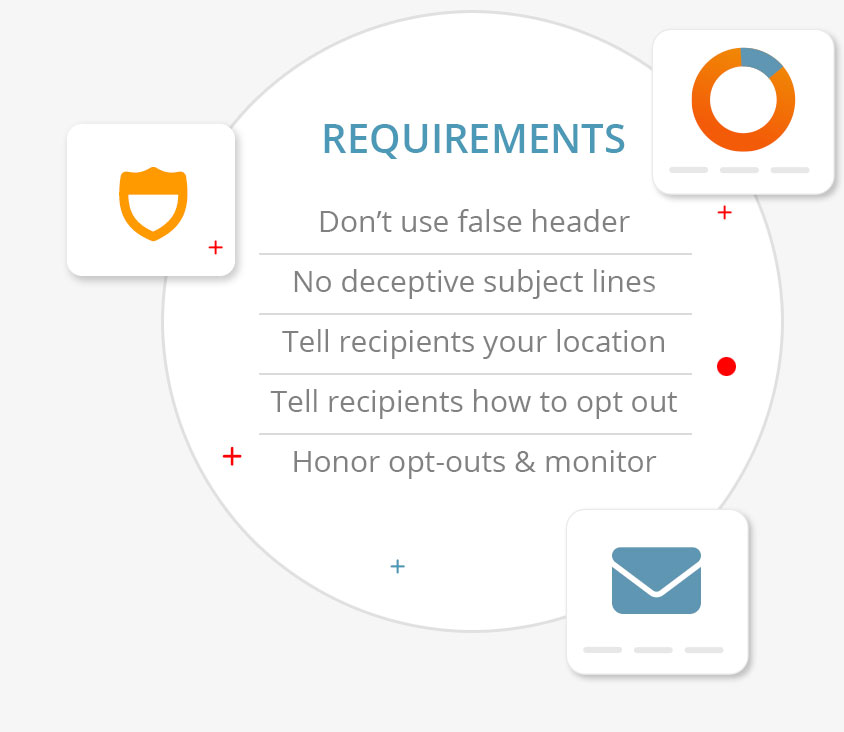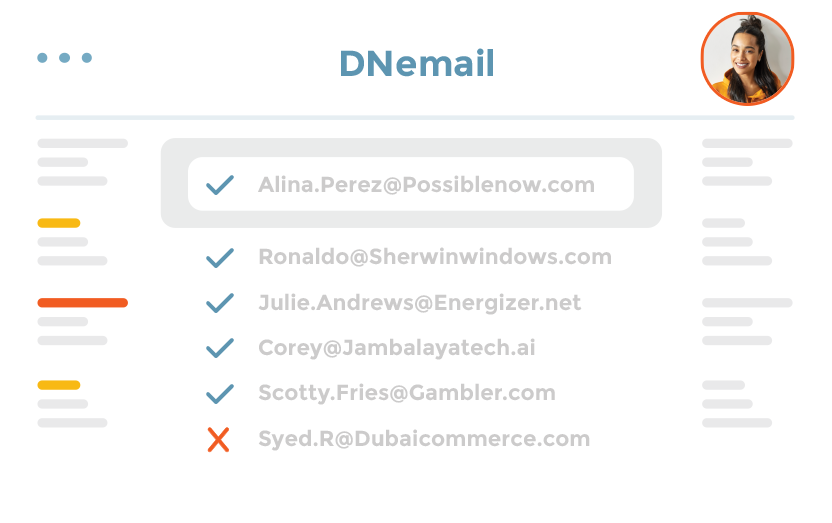Do Not Email Overview
DNemail Features
Prior to any campaign, “scrub” your email list against your internal Do Not Email database to ensure compliance.
Learn More
CAN-SPAM Requirements
Maintain compliance with the key requirements of the CAN-SPAM Act to minimize exposure to fines up to $16,000 per violation.
Learn More
CASL Compliance
If you conduct marketing to Canadian consumers, you must comply with their unique laws regulating commercial electronic marketing (CEM) messages.
Learn More
FEATURES
DNemail Features Help You Maintain Compliance
Prior to any email campaign, you must "scrub" your email list against your internal database of Do Not Email requests. This provides you with a file of email addresses of people who wish to receive your commercial marketing messages.
- Handles high volume email list scrubbing
DNemail's performance is amazingly fast whether you have thousands or even millions of email addresses to scrub. - Allows checking of a single email addresses
Get instant feedback on whether you have permission to email a specific person. - Allows seamless integration with your existing systems via Web Services
Add and check email opt-outs from within legacy applications.
- Provides a "one click" opt-out solution
Comply with CAN-SPAM requirements by providing prospects and customers “one click” opt-out functionality. - Manage opt-out requests by company, division, department, product, or campaign
Customize how you collect opt-out or unsubscribe requests. This capability lets people choose which specific information they wish to receive from you via email and helps prevent global opt-outs. - Provides scrub receipt
Scrub receipts serve as a record of your email compliance efforts and protects you in the event of a regulatory inquiry. - Maintains historical archive of all opt-out requests
Maintaining an archive of opt-out requests helps you demonstrate compliance.
RISKS
CAN-SPAM: Key Provisions & Risks
Below are key elements of the CAN-SPAM Act. Violations of the provisions are subject to fines of up to $16,000.
- Don't use false or misleading header information
Your "From", "To", "Reply-To", and routing information - including the originating domain name and email address – must be accurate and identify the person or business who initiated the message. - Don't use deceptive subject lines
The subject line must accurately reflect the content of the message. - Tell recipients where you're located
Your message must include your valid physical postal address. This can be your current street address, a post office box you've registered with the U.S. Postal Service, or a private mailbox you've registered with a commercial mail receiving agency established under Postal Service regulations. - Tell recipients how to opt out of receiving future email from you
Your message must include a clear and conspicuous explanation of how the recipient can opt out of getting email from you in the future. You may create a menu to allow a recipient to opt out of certain types of messages, but you must include the option to stop all commercial messages from you. - Honor opt-out requests promptly
Any opt-out mechanism you offer must be able to process opt-out requests for at least 30 days after you send your message. You must honor a recipient's opt-out request within 10 business days.
You can't charge a fee, require the recipient to give you any personally identifying information beyond an email address, or make the recipient take any step other than sending a reply email or visiting a single page on an Internet website as a condition for honoring an opt-out request.
Once people have told you they don't want to receive more messages from you, you can't sell or transfer their email addresses, even in the form of a mailing list. The only exception is that you may transfer the addresses to a company you've hired to help you comply with the CAN-SPAM Act. - Monitor what others are doing on your behalf
The law makes clear that even if you hire another company to handle your email marketing, you can't contract away your legal responsibility to comply with the law. Both the company whose product is promoted in the message and the company that actually sends the message may be held legally responsible.


CASL
Canadian Anti-Spam Legislation (CASL): Key Provisions & Risks
If you conduct marketing to Canadian consumers, you need to comply with their unique laws regulating commercial email and text messages.
- CASL applies to everyone
Individuals, incorporated and unincorporated businesses, not-for-profit organizations, etc. who send electronic messages for commercial purposes must comply with CASL.
- CASL requires consent for all electronic messages
The Canadian law requires senders to collect oral or written consent to receive commercial electronic messages (emails, text messages, instant messages, and messages sent via social media networks.) - To obtain consent, you must:
Clearly describe the purposes for requesting consent Provide the name of the person or organization seeking consent Provide contact information (mailing address, and a phone number or email address) Indicate the recipient can unsubscribe - Prior to sending CEMs, you must perform a CASL-compliant “data scrub”
You must ensure that you have the required level of consent — email address or phone number, date collected, the Established Business Relationship (EBR) type and the country code (optional). Ensure that the consumer has not opted out

